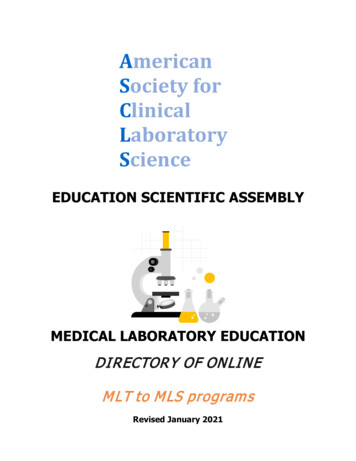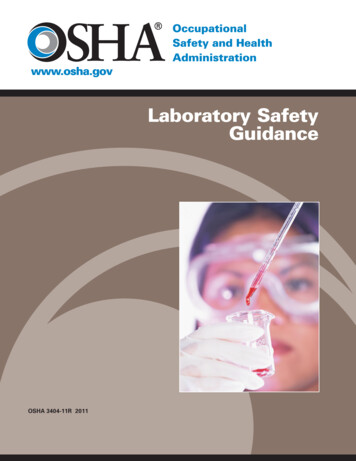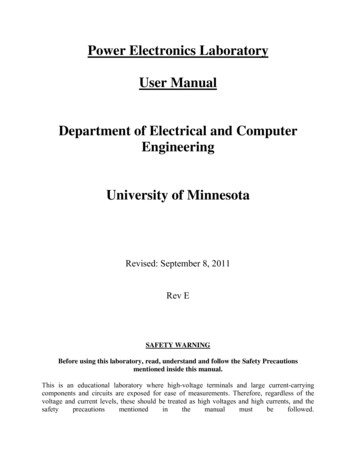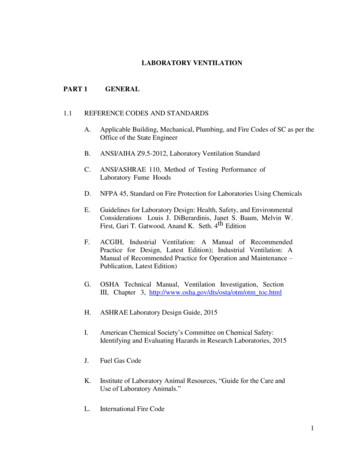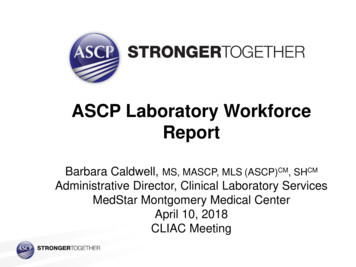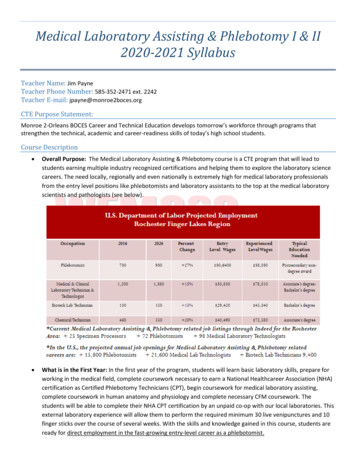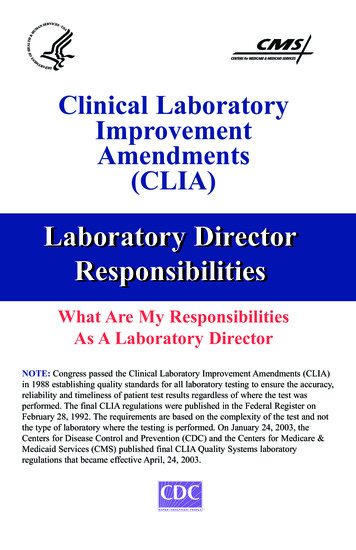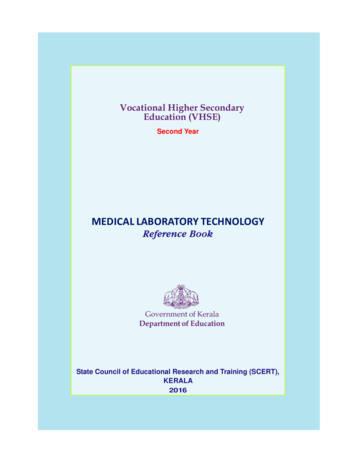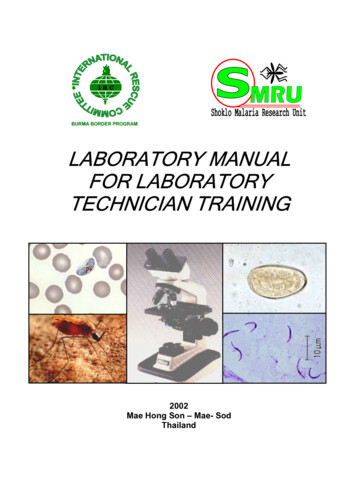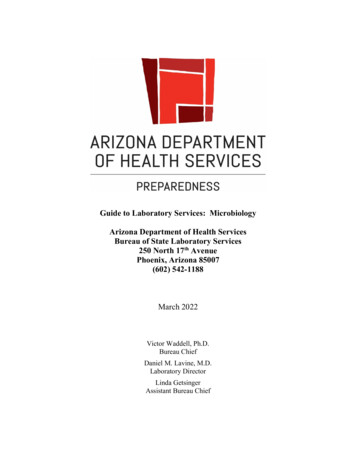
Transcription
Guide to Laboratory Services: MicrobiologyArizona Department of Health ServicesBureau of State Laboratory Services250 North 17th AvenuePhoenix, Arizona 85007(602) 542-1188March 2022Victor Waddell, Ph.D.Bureau ChiefDaniel M. Lavine, M.D.Laboratory DirectorLinda GetsingerAssistant Bureau Chief
Table of ContentsTable of Contents2General Information . 3Arizona State Public Health Laboratory Contact Information . 4Core Functions and Capabilities of State Public Health Laboratories. 5Sample Submission for Testing . 5Collection Kits and Mailing Containers. 6Courier Services . 6Reporting . 6Specimen Rejection Policy . 7Section 1: Sample Submission Guidelines . 8IATA Category A Organisms . 12Category A Shipping Examples . 13Category B Shipping Examples . 14Category B Checklist . 15Dry Ice Checklist . 16Section 2:Section 3:Section 4:Section 5:Bacteriology .17Mycobacteriology .20Limited Parasitology .21Food Product and Water Sample Testing.22Food Product Samples . 22Water Samples . 23Section 6: Serology .25Section 7: Virology .30Section 8: Special Virology – Rabies .35Section 9: Bioemergency Detection and Response (Select Agents) .37Section 10: Requesting Collection Kits and Mailing Containers .41Issued: 03.24.2022-2-Controlled Copy # UNCONTROLLED
General InformationBureau Chief, Laboratory ServicesVictor Waddell, Ph.D.Director, Laboratory ServicesDaniel M. Lavine, M.D.Assistant Bureau ChiefLinda GetsingerHours of Operation:8:00 AM to 5:00 PM Monday through Friday (Emergency servicesavailable outside business hours when required by public healthneeds.)Receiving section only is open from 9:30 AM to 4:30 PM onSaturday.Annual Holiday Schedule:Laboratory Services observes all state-recognized holidays.Location:250 North 17th Avenue, Phoenix, Arizona 85007Telephone Number:(602) 542-1188WATTS Line:(800) 525-8915Fax Number:(602) 542-0760Emergency Phone(Weekends/After Hours):(480) 955-0888Issued: 03.24.2022-3-Controlled Copy # UNCONTROLLED
Arizona State Public Health Laboratory Contact InformationSectionSupervisorContact InformationChief, MicrobiologyLinda Getsinger(Interim)Virology / SerologyKathryn Fitzpatrick,MBA/MPHTB / MycobacteriologyBacteriology / (Limited) Parasitology /Bioemergency Response and Detection forSelect Agents / Food TestingDrew Francis(602) 542-1150Drew.Francis@azdhs.govAdvanced Molecular Detection /Laboratory Testing SupportTrung Huynh, Ph.D.(602) 542-6130Trung.Huynh@azdhs.govChief, Laboratory Support ServicesJoseph Manfrida, Ph.D.Analytical Preparation ServicesMichael WorshamReceiving / ShippingAdrian Fichter(602) 542-6146(602) 364-0999Linda.Getsinger@azdhs.gov(602) 542-0968VirologySerologyLab@azdhs.gov(602) 364-2359Joseph.Manfrida@azdhs.gov(602) 542-1147Michael.Worsham@azdhs.gov(602) 542-1190labreceiving@azdhs.govArizona Department of Health – Bureau of Epidemiology and Disease ControlOffice of Infectious Disease ServicesMain NumberAfter Hours(602) 364-3676(480) 303-1191State EpidemiologistKen Komatsu(602) 364-3587Issued: 03.24.2022-4-Controlled Copy # UNCONTROLLED
Core Functions and Capabilities of State Public Health LaboratoriesState public health laboratories face the broad challenge of working towards prevention andcontrol of disease and improvement of health. To function in this capacity, the public health labsprovide testing for, and aid in the diagnosis of, unusual pathogens. The labs serve as the first lineof defense in the rapid recognition and prevention of the spread of communicable diseases, whilealso serving as centers of expertise for the detection and identification of biologic agents ofimportance in human disease. The public health labs also perform testing to meet the specificprogram needs of the public health agencies.Routine diagnostic testing for hospitals and private laboratories is provided throughindependent reference laboratories.The policy of the Arizona State Public Health Laboratory (ASPHL) is to provide microbiologyand immunology diagnostic support to federal, state, county, and tribal agencies. In addition, theASPHL serves as a reference microbiology laboratory to hospital and independent clinicallaboratories in order to confirm their atypical results from cultures and clinical specimens. Thisinformation is also used as part of the Department of Health Services disease surveillanceprogram. Selected diagnostic test procedures are available to private medical practitioners whena procedure is not available through independent reference laboratories or when intensesurveillance is deemed necessary. The laboratory also accepts food and water from county andstate agencies for outbreak investigations and surveillance. Upon specific request to the StateLaboratory, the ordering provider (listed in the Ordering Provider Information section of theMicrobiology Sample Submission form) will be given test results in addition to the submittingagency. Otherwise, test results will be only given to the submitting agency.ASPHL reporting requirements can be found at http://azdhs.gov/labreporting. This reportidentifies agents which must be reported to the state and which isolates must be submitted to thelaboratory. Please follow packing guidelines found in this manual, or on our website athttp://www.azdhs.gov/lab/ .Sample Submission for TestingASPHL requires all clinical samples to be submitted using the electronic laboratory submissionform. All submission forms must have the barcode generated on the form for the accessioning ofsamples. Please ensure to use the current submission form as samples submitted using theprevious versions are subject to rejection.Approved submitters can use the electronic test orders and results portal (ETOR). This platformwill allow submitters to submit test orders and monitor the progress of the sample throughout thetesting process. Notification of completion of testing and results reporting will be given to selectusers as specified in the portal. Please contact Laboratory Support Services at (602) 364-2359 foryour facility to be able to access the portal.Food, water, and environmental samples may also be submitted for testing. The appropriateforms may be accessed at y/shipping-Issued: 03.24.2022-5-Controlled Copy # UNCONTROLLED
receiving/index.php#forms-home. Please do NOT use the clinical electronic submission form forenvironmental, food, or water testing.Collection Kits and Mailing ContainersASPHL provides specimen collection materials and mailers free of charge. Further informationregarding specimen collection materials, mailing containers and Request for Materials Form islocated in Section 10: Requesting Collection Kits and Mailing Containers. Submission formsand supplies for specimen submission are available through the Receiving section ory/shipping-receiving/index.php.Courier ServicesASPHL uses Specialized Delivery Services for courier services. The schedule for routine pickupas well as will-call services for shipment and delivery can be found on the ADHS website te-laboratory/lsip/courier-schedule.pdf. Ifyour facility is not currently on the route for pickup, please contact Laboratory Support Servicesat (602) 364-2359.ReportingResults will only be communicated to the submitting agencies and providers listed on thesubmission/requisition form. Laboratory results may be available to the local jurisdictional healthdepartments. ASPHL has different mechanisms to report results. Reports can be emailed to apoint of contact, faxed to a single number, or sent through mail. To have reports emailed or faxedto your facility, please contact Receiving at (602) 542-1190 or Laboratory Support Services at(602) 364-2359.MyLIMS is a web interface application which submitting agencies can access to retrieve theirresults/reports. ASPHL allows a limited number of representatives per site access to thisapplication. To have access, please contact Laboratory Support Services at (602) 364-2359.ASPHL has recently implemented the use of an electronic test orders and results (ETOR)platform. This platform will allow submitters to monitor the life of a sample from submission toreporting. To have access to this multifunctional portal, please contact Laboratory SupportServices at (602) 364-2359.Issued: 03.24.2022-6-Controlled Copy # UNCONTROLLED
Specimen Rejection PolicyThe ASPHL currently has the following policy for rejection of laboratory specimens and/orrequested examinations. The ASPHL will NOT examine clinical/reference specimens if thefollowing circumstances exist: Test is routinely available at a hospital or a private independent laboratory. The identifier on the specimen did not match the identifier on the submission form, orthere was no identification on the specimen. The quantity of specimen was not sufficient for examination. The specimen was too long in transit between the time of collection and receipt in thelaboratory. The specimen was broken or leaked in transit. Clinical/epidemiological information submitted with the specimen was either insufficientor incomplete. Specimen was submitted in an improper or expired container, transport media orpreservative. Blood specimens were hemolyzed or contaminated. Only acute blood specimen was submitted, no convalescent specimen (if applicable). Material for rabies examination was too decomposed or desiccated to test. Reference cultures were mixed or contaminated; only pure cultures are acceptable. Specimens were not submitted in individual containers. Test request deemed unnecessary by the Bureau of Epidemiology and Disease Control. Use of outdated submission formsExceptions to this policy will be considered due to extenuating circumstances; however, finalapproval to make an exception can only be made by the Laboratory Director, Bureau Chief,Assistant Bureau Chief, or Chief of Microbiology.Issued: 03.24.2022-7-Controlled Copy # UNCONTROLLED
Section 1: Sample Submission GuidelinesSection 1: Sample Submission GuidelinesSubmit all samples to the following location:Arizona Department of Health ServicesState Public Health Laboratory250 N. 17th AvePhoenix, AZ 85007(602) 542-1188All infectious material must be classified as either Category A (UN2814) or B (UN3373) andmust be transported to the Arizona State Public Health Laboratory according to appropriateIATA (International Air Transportation Association), USPS (United States Postal Service) andDOT (U.S. Department of Transportation) regulations. The list of Category A organisms asoutlined by IATA is contained at the end of this section. All infectious material must be triplepackaged to protect against breakage and/or leakage during transportation. An ASPHLSubmission Form must accompany every sample submitted for testing; the forms are omeCategory B shipments must follow Packaging Instruction (PI) 650. Category A shipments mustfollow PI 620 and shipments with dry ice must follow PI 954. All samples and their containersmust be identified with the appropriate labels, client and patient information.Any samples which are leaking and/or not properly identified will be rejected. The following arebrief guidelines for properly triple-packaging and shipping specimens for infectious testing at theArizona State Public Health Laboratory: Primary Containero Must be securely sealed; leak-proof for liquids and sift-proof for solids NOTE: Screw caps and parafilm recommended NOTE: Primary OR secondary container must be pressure andtemperature capable (95 kPa) if air transportation is usedo Samples must be properly labeled with patient identifying information Specimen primary containers for Mycobacterial examination must belabeled with the patient’s name, specimen type, date AND time of thecollection.o For Category A, the maximum quantity for a cargo plane is 4 L or 4 kg. For apassenger plane, the maximum quantity is 50 mL or 50 g.o For Category B, the maximum quantity is 500 mL or 500 g.o Wrap with absorbent material sufficient for entire contents, and cushioningmaterial. Secondary ContainerIssued: 03.24.2022-8-Controlled Copy # UNCONTROLLED
Section 1: Sample Submission Guidelineso Securely sealed and watertight/leak-proof NOTE: Primary OR secondary container must be pressure andtemperature capable (95 kPa) if air transportation is used. NOTE: If you have the appropriate materials you can place multipleprimary containers inside a secondary container.o A completed itemized list of contents must be placed outside of or surroundingthe secondary container. NOTE: An ASPHL Submission Form will satisfy the list of contentsrequirement.o Place absorbent and cushioning material between the primary and secondarycontainers.o Affix a biohazard symbol to the secondary container. Tertiary/Outer Container for CATEGORY B shipmentso Outer package must be rigid and of good qualityo Affix UN3373 Biological Substance, Category B diamond shaped hazard label. Do NOT affix biohazard symbol to outer packageo Full name, complete address and phone number of shipper (responsible person).o Full name, complete address and phone number of recipient. Tertiary/Outer Container for CATEGORY A shipmentso Outer package and inner containers must be UN certified, outer package mustcontain the UN symbol.o For Category A shipments containing infectious material affecting humans, affixUN2814 Infectious Substances, Affecting Humans diamond shaped hazardlabel.o For Category A shipments containing infectious material affecting animals, affixUN2900 Infectious Substances, Affecting Animals diamond shaped hazardlabel. NOTE: A list of UN2814 and UN2900 organisms is contained at the endof this section. NOTE: If the infectious material affects both humans and animals, thentreat as UN2814.o Orientation marks (up arrows) must be present on two (2) sides of outer box.o Full name, complete address and 24-hour direct phone number of shipper(responsible person).o Full name, complete address and phone number of recipient.o NOTE: Make sure to write 6.2 above the UN2814 of the label. Leave thetechnical name off of the box.o NOTE: You must include the full technical name of the suspected unknown orSelect Agent on the Dangerous Goods Form placed in with the SecondaryContainer.o For Infectious Substance and Dry Ice Label template examples, refer to theASPHL Shipping/Receiving website y/index.php#shippingreceiving-shipping Additional Documentation and ConsiderationsIssued: 03.24.2022-9-Controlled Copy # UNCONTROLLED
Section 1: Sample Submission Guidelineso Temperature Considerations Consult appropriate sections within this Guide to Laboratory Servicesdocument for specific shipping temperatures based on the organism orlaboratory section performing test. If wet ice or ice packs are to be used for maintaining refrigerated shippingtemperatures, ensure there is sufficient absorbent material containedwithin to absorb all moisture if ice melts during transit so integrity of boxis not compromised. NOTE: It is recommended to place wet ice and/or ice packs insidea zip-lock bag and surround this with absorbent material. If dry ice is to be used to maintain sub-frozen temperatures ensure that thepackage conforms to PI 954 and that dry ice is not placed inside anytightly sealed container that will prevent the release of carbon dioxide gasduring sublimation. NOTE: Dry ice will degrade rapidly therefore it must bepurchased, obtained and used as close to actual shipping aspossible.o Dangerous Goods Shipper’s Declaration A Shipper’s Declaration must accompany all Category A shipments. NOTE: A minimum of 3 color and signed copies is needed. A Shipper’s Declaration is not needed for Category B shipments. A Shipper’s Declaration is not needed if only shipping dry ice, or dry icewith a Category B shipment.o Select Agent and Toxin Transfers Shipping of any known Select Agent or Toxin must have prior approvaland a completed CDC/APHIS Form 2. Any “suspected” Select Agents must be shipped as either Category A orCategory B as designated by its classification. For additional information please visit the Select Agents website at:http://www.selectagents.gov/form2.html or contact the Arizona StatePublic Health Laboratory Bioemergency Response section at(602) 364-0999 for further assistance.o Training Anyone who packages or ships infectious material must receiveappropriate training. There are several “hands-on” and online courses andtrainings available. For further information or the next scheduled courseplease contact the ASPHL Technical Trainer at (602) 542-6175.o Supplies The Arizona State Public Health Laboratory offers several collection kitsand materials for submitting samples. Please see Section 10 for furtherinformation.o Regulations and Additional GuidanceIssued: 03.24.2022- 10 -Controlled Copy # UNCONTROLLED
Section 1: Sample Submission Guidelines Issued: 03.24.2022Arizona State Reporting and Isolate Submission Requirements A.A.C. R96-204http://azdhs.gov/labreportingCDC/USDA Select Agent and Toxin andAdvocacy/Biosafety Sentinel Guideline October 2018 FINAL.pdfDOT (Department of Transportation) 49 CFR Part 171-180, HazardousMaterials Regulations: http://www.ecfr.gov/cgi-bin/textidx?tpl /ecfrbrowse/Title49/49cfrv2 02.tplUnited States Postal Service (USPS) 39 CFR Part 20, International PostalService (International Mail Manual), and Part 111, General Information onPostal Service (Domestic Mail Manual). Regulations on transportinginfectious substances through the USPS are codified in Section 601.10.17of the Domestic Mail Manual and Section 135 of the International MailManual. A copy of the Domestic and International Mail Manuals may beobtained from https://about.usps.com/manuals/welcome.htm or theGovernment Printing Office by calling Monday through Friday, 7:30 a.m.- 9:00 p.m. EST: (202) 512-1800, (866) 512-1800 (toll free), or tional Health and Safety Administration (OSHA). 29 CFR Part1910.1030, Occupational Exposure to Bloodborne s/standardnumber/1910/1910.1030Technical Instructions for the Safe Transport of Dangerous Goods by Air(Technical Instructions). International Civil Aviation Organization(ICAO). A copy of these regulations may be obtained from the ICAODocument Sales Unit at (514) 954-8022, Fax: (514) 954-6769, E-Mail:sales unit@icao.int, or ges/Doc9284-TechnicalInstructions.aspxDangerous Goods Regulations International Air Transport Association(IATA). These regulations are issued by an airline association, are basedon the ICAO Technical Instructions, and are followed by most airlinecarriers. A copy of these regulations can be obtained from:https://www.iata.org/en/publications/dgr/ iosafety/WHO HSE EPR 2008 10.pdfPlease contact the Arizona State Public Health Laboratory (ASPHL) forappropriate specimen types and shipping instructions for specimen referralto the Centers for Disease Control and Prevention (CDC) for non-routinetesting not offered at the ASPHL.- 11 -Controlled Copy # UNCONTROLLED
Section 1: Sample Submission GuidelinesThe following list is not exhaustive. It is the list of Category A organisms as outlined by theIATA regulations. If there is any doubt as to whether the shipment should be sent as Category Aor B, please contact the Arizona State Public Health Laboratory at (602) 542-1190 or(602) 364-0999 for assistance.IATA Category A OrganismsRef: IATA Dangerous Goods Regulation 60thMicro-OrganismEdition, January 2019: 3.6.2.2 Classification ofInfectious Substances Table 3.6 D UN number andproper shipping nameUN 2814Infectious substances, affecting humansBacillus anthracis (cultures only)Brucella abortus (cultures only)Brucella melitensis (cultures only)Brucella suis (cultures only)Burkholderia mallei-Pseudomonas mallei-Glanders (cultures only)Burkholderia pseudomallei-Pseudomonas pseudomallei (cultures only)Chlamydia psittaci (avian) (cultures only)Clostridium botulinum (cultures only)Coccidioides immitis (cultures only)Coxiella burnetii (cultures only)Crimean-congo hemorrhagic fever virusDengue virus (cultures)Eastern equine encephalitis virus (cultures only)Escherichia coli, verotoxigenic (cultures only)Ebola virusFlexal virusFrancisella tularensis (cultures only)Guanarito virusHantaan virusHantavirus causing hemorrhagic fever with renal syndromeHendra virusHepatitis B virus (cultures only)Herpes B virus (cultures only)Human immunodeficiency virus (cultures only)Highly pathogenic avian influenza virus (culture only)Japanese Encephalitis virus (culture only)Junin virusKyasanur Forest disease virusLassa virusMachupo virusMarburg virusMonkeypox virusMycobacaterium tuberculosis (cultures only)Nipah virusOmsk haemorrhagic fever virusPoliovirus (cultures only)Rabies virusRickettsia prowazekii (cultures only)Rickettsia rickettii (cultures only)Rift Valley fever virus (cultures only)Russian spring-summer encephalitis virus (cultures only)Sabia virusShigella dysenteriae type 1 (cultures only)Tick-borne encephalitis virus (cultures only)Variola virusVenezuelan equine encephalitis virusWest Nile virus (cultures only)Yellow fever virus (cultures only)Yersinia pestis (cultures only)UN 2900Infectious substances, affecting animalsAfrican swine fever virus (cultures only)Avian paeamyxovirus Type 1 – Velogenic Newcastle disease virus (culturesonly)Classical swine fever virus (cultures only)Foot-and –mouth disease virus (cultures only)Goatpox virus (cultures only)Lumpy skin disease virus (cultures only)Mycoplasma mycoides – Contagious bovine pleuropneumonia (cultures only)Peste des petits ruminants virus (cultures only)Rinderpest virus (cultures only)Sheep-pox virus (cultures only)Swine vesicular disease virus (cultures only)Vesicular stomatitis virus (cultures only)Issued: 03.24.2022- 12 -Controlled Copy # UNCONTROLLED
Section 1: Sample Submission GuidelinesCategory A Shipping ExamplesIssued: 03.24.2022- 13 -Controlled Copy # UNCONTROLLED
Section 1: Sample Submission GuidelinesCategory B Shipping ExamplesIssued: 03.24.2022- 14 -Controlled Copy # UNCONTROLLED
Section 1: Sample Submission GuidelinesCategory B ChecklistIssued: 03.24.2022- 15 -Controlled Copy # UNCONTROLLED
Section 1: Sample Submission GuidelinesDry Ice ChecklistIssued: 03.24.2022- 16 -Controlled Copy # UNCONTROLLED
Section 2: BacteriologySection 2: BacteriologyFor testing assistance for organisms/diseases not offered by the ASPHL please contact theBacteriology section at (602) 542-6132. ASPHL partners with various public health laboratoriesfor testing support if necessary. Additional testing resources are available from the Centers forDisease Control and Prevention (CDC), Minnesota Public Health Laboratory (MPHL), UtahPublic Health Laboratory (UPHL). Specimens should be forwarded to the CDC from the ASPHLand should not be sent directly from other facilities; please contact the Bacteriology section withany questions or for sample coordination with bacteriology or parasitology related ndTime(TAT)BusinessDaysNasopharyngeal swab inReagan-Lowe semi-solidtransport mediaPCRUse polyester NP swabs7 daysCulture,PCRSend automated instrumentand manual susceptibilityreports and results withspecimen7-14 daysReferredto CDCApproval for botulismtesting must be obtainedfrom the Bureau ofEpidemiology and DiseaseControl prior to submission.Contact the InfectiousDisease Section of theBureau of Epidemiologyand Disease Control at(602) 364-3676 (mainnumber)/ (480) 303-1191(after hours number).12 weeksBordetella pertussisBordetellaparapertussisBordetella holmesiiCarbapenemresistantEnterobacteriaceae(CRE) &Pseudomonasaeruginosa (CRPA)Actively growing pureculture on suitablemediumSerum, Feces, Food.ClostridiumbotulinumIssued: 03.24.2022*Refer to the specimencollection guidelines listedbelow.- 17 -Controlled Copy # UNCONTROLLED
Section 2: imenNasopharyngeal swab, orthroat swab, placed into aSemi-sold transport media.Deliver to the laboratoryimmediately within 24hours of usinessDaysCultureApproval for botulismtesting must be obtainedfrom the Bureau ofEpidemiology and DiseaseControl prior to submission.Contact the InfectiousDisease Section of theBureau of Epidemiologyand Disease Control at(602) 364-3676 (mainnumber)/ (480) 303-1191(after hours number).2-6 daysRaw stools must be receivedand processed within 2hoursPreserved stool received andprocessed within 3 daysEnteric CultureRaw stool or preservedstool in ParaPak C&S,Modified Cary-Blair ly growing pureculture on suitablemediumCultureLegionella spp.Actively growing pureculture on suitablemediumCulture,PCR7-14 daysListeria spp.Actively growing pureculture on suitablemediumCulture7-14 daysNeisseriameningitidisActively growing pureculture on suitablemediumCultureIssued: 03.24.2022- 18 -Stool samples, unlessotherwise specified, will bescreened for Salmonella,Shigella, Campylobacter,Shiga toxin-producing E.coli, and upon requestAeromonas, Plesiomonas,Yersinia, and Vibrio.Children 5 years andyoungerReferred to MDH forSerotyping7-14 days7-14 daysControlled Copy # UNCONTROLLED
Section 2: mSpecimenTestMethodSalmonella spp.Actively growing pureculture on suitablemedium or preserved stoolin ParaPak C&S, ModifiedCary-Blair or equivalentCulture7-14 daysShiga Toxigenic E.coliActively growing pureculture on suitablemedium or preserved stoolin ParaPak C&S, ModifiedCary-Blair or equivalentCulture,PCR7-14 daysVibrio spp.Actively growing pureculture on suitablemedium or preserved stoolin ParaPak C&S, ModifiedCary-Blair or equivalentCulture7-14 daysVISA/VRSAActively growing pureculture on suitablemediumCultureYersinia spp.Actively growing pureculture on suitablemedium or preserved stoolin ParaPak C&S, ModifiedCary-Blair or equivalentCultureIssued: 03.24.2022- 19 -CommentsSend automated instrumentand manual susceptibilityreports and results withspecimen5-7 days7-14 daysControlled Copy # UNCONTROLLED
Section 3: MycobacteriologySection 3: MycobacteriologyFor more information about specimen collection and shipping refer to the Specimen Collection& Shipment Guide found at .Test NameSpecimensTest MethodMycobacteriumspp. –Clinical SamplesAcceptable clinical samplesinclude: Sputum, Urine, GastricWashings, Stool, cerebrospinalfluid (CSF), pleural fluid, asciticfluid, joint fluid, pus, exudates,biopsy, and autopsy tissuesConcentratedacid-fast smear,CultureMy
The following table lists the diagnostic and reference services offered by the Office of Public Health Microbiology. The table is organized alphabetically by disease or agent for easy . Please go to the specified laboratory section of this manual for more detailed reference inform


